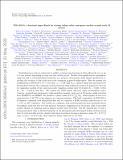TOI-1235 b : a keystone super-earth for testing radius valley emergence models around early M dwarfs
Abstract
Small planets on close-in orbits tend to exhibit envelope mass fractions of either effectively zero or up to a few percent depending on their size and orbital period. Models of thermally driven atmospheric mass loss and of terrestrial planet formation in a gas-poor environment make distinct predictions regarding the location of this rocky/nonrocky transition in period-radius space. Here we present the confirmation of TOI-1235 b (P = 3.44 days, rp = 1.738-0.076+0.087 R⊕), a planet whose size and period are intermediatebetween the competing model predictions, thus making the system animportant test case for emergence models of the rocky/nonrockytransition around early M dwarfs (Rs = 0.630 ± 0.015 R⊙, Ms = 0.640 ± 0.016 M⊙). We confirm the TESS planet discovery using reconnaissance spectroscopy, ground-based photometry, high-resolution imaging, and aset of 38 precise radial velocities (RVs) from HARPS-N and HIRES. We measure a planet mass of 6.91-0.85+0.75 M⊕, which implies an iron core mass fraction of 20-12+15% in the absence of a gaseous envelope. The bulk composition of TOI-1235 b is therefore consistent with being Earth-like, and we constrain an H/He envelope mass fraction to be <0.5% at 90% confidence. Our results are consistent with model predictions from thermally driven atmospheric mass loss but not with gas-poor formation, suggesting that the former class of processes remains efficient at sculpting close-in planets around early M dwarfs. Our RV analysis also reveals a strong periodicity close to the first harmonic of the photometrically determined stellar rotation period that we treat as stellar activity, despite other lines of evidence favoring a planetary origin (P = 21.8-0.8+0.8 days, mp sin i = 13.0-5.3+3.8 M⊕) that cannot be firmly ruled out by our data.
Citation
Cloutier , R , Rodriguez , J E , Irwin , J , Charbonneau , D , Stassun , K G , Mortier , A , Latham , D W , Isaacson , H , Howard , A W , Udry , S , Wilson , T G , Watson , C A , Pinamonti , M , Lienhard , F , Giacobbe , P , Guerra , P , Collins , K A , Beiryla , A , Esquerdo , G A , Matthews , E , Matson , R A , Howell , S B , Furlan , E , Crossfield , I J M , Winters , J G , Nava , C , Ment , K , Lopez , E D , Ricker , G , Vanderspek , R , Seager , S , Jenkins , J M , Ting , E B , Tenenbaum , P , Sozzetti , A , Sha , L , Ségransan , D , Schlieder , J E , Sasselov , D , Roy , A , Robertson , P , Rice , K , Poretti , E , Piotto , G , Phillips , D , Pepper , J , Pepe , F , Molinari , E , Mocnik , T , Micela , G , Mayor , M , Martinez Fiorenzano , A F , Mallia , F , Lubin , J , Lovis , C , López-Morales , M , Kosiarek , M R , Kielkopf , J F , Kane , S R , Jensen , E L N , Isopi , G , Huber , D , Hill , M L , Harutyunyan , A , Gonzales , E , Giacalone , S , Ghedina , A , Ercolino , A , Dumusque , X , Dressing , C D , Damasso , M , Dalba , P A , Cosentino , R , Conti , D M , Colón , K D , Collins , K I , Cameron , A C , Ciardi , D , Christiansen , J , Chontos , A , Cecconi , M , Caldwell , D A , Burke , C , Buchhave , L , Beichman , C , Behmard , A , Beard , C & Akana Murphy , J M 2020 , ' TOI-1235 b : a keystone super-earth for testing radius valley emergence models around early M dwarfs ' , Astronomical Journal , vol. 160 , no. 1 , 22 . https://doi.org/10.3847/1538-3881/ab9534
Publication
Astronomical Journal
Status
Peer reviewed
ISSN
0004-6256Type
Journal article
Description
Funding: R.C. is supported by a grant from the National Aeronautics and Space Administration in support of the TESS science mission. M.P. gratefully acknowledges the support from the European Union Seventh Framework Programme (FP7/2007-2013) under grant agreement No. 313014 (ETAEARTH). J.M.A.M. gratefully acknowledges support from the National Science Foundation Graduate Research Fellowship Program under grant No. DGE-1842400. J.M.A.M. also thanks the LSSTC Data Science Fellowship Program, which is funded by LSSTC, NSF Cybertraining grant No. 1829740, the Brinson Foundation, and the Moore Foundation. This work has been partially supported by the National Aeronautics and Administration under grant No.NNX17AB59G issued through the Exoplanets Research Program. The MEarth Team gratefully acknowledges funding from the David and Lucile Packard Fellowship for Science and Engineering (awarded to D.C.). This material is based onwork supported by the National Science Foundation undergrants AST-0807690, AST-1109468, AST-1004488 (Alan T.Waterman Award), and AST-1616624. This work is made possible by a grant from the John Templeton Foundation.Collections
Items in the St Andrews Research Repository are protected by copyright, with all rights reserved, unless otherwise indicated.

